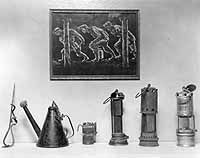| Above and below, Lighting equipment used in the mines has evolved considerably. Miners began lighting with a candle stick which was stuck in the mine. They have progressed to more sophisticated equipment. This collection is part of Jack Pressett’s memorabilia from a lifetime around coal mines. Each time the equipment was upgraded, it was more efficient and safer for the miner. |
Almost everything evolves. Better, safer and more efficient seems to be the motivation behind most inventions or upgrades. Coal mining and making light in the mines are no exception. With the large numbers of families in Carbon county that have deep roots in coal mines there are probably many collections of these types of equipment. One such collection that has made light in the mines over the years is in the possession of Jack Pressett, former miner and historian.
As the equipment is reviewed, it is important to remember that it is totally black in these mines. The first method of providing light was the use of a candle stick, stuck in a prop. This provided the miner with enough light to mine the precious black gold. This method was probably used in the early to mid 1800s and because the methane gas in the mines is highly explosive and the candle had an exposed flame. Miners had to figure out methods of staying safe.
A couple of methods including putting an oil rag on the end of a long stick and if it blew up then the miners knew there was dangerous gas in the mine.
Another method believed to be used was to take canaries into the mine. Since canaries have to have oxygen to live, a dead canary meant that there wasn’t enough oxygen in the shaft and it wasn’t safe.
Another lighting source was the oil lamp fed with a wick for just enough oil to last for one day of mining.
The third method was a carbide lamp which was carried on the head gear of the miner. This lamp produced a much better light and assisted the miner to work a longer day in a much brighter work area. These lamps were used in the early 1900s. A draw back was that additional carbide had to be carried, but it was easier to carry than oil and less explosive.
The safety lamp came next. This invention produced a small gas flame that could be used to measure or indicate if there was hazardous methane gas in the shaft. The lamp could also be used to detect lack of oxygen and presence of carbon monoxide, deadly enemies of the coal miners. Pressett explained that this lamp was a three-in-one invention and provided a great deal of light for the miner.
The fifth type of lighting was the use of head lamps that were battery operated. These permitted the miner to see very well and work extended significantly above and beyond the eight hour time period.
Should the lights go out while the miner was working, the miner had 30 minutes to get to safety.
The method used today is an oxygen tank attached to the helmet.

